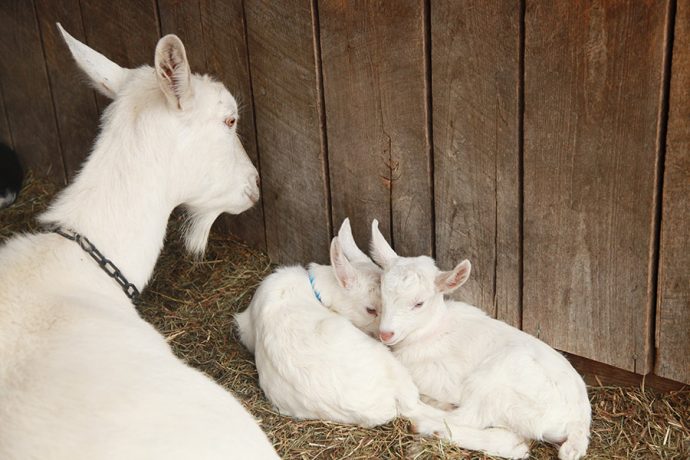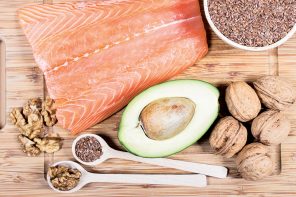In “So Big,” a Pulitzer Prize-winning novel about the sterile nature of greed, Edna Ferber identifies two kinds of people — wheat, those who express their creativity through nature; and emeralds, those who express it through the arts.
But perhaps there is a third kind — those who bridge the two.
At Big Picture Farm, an 86-acre spread in Townshend, Vermont, Louisa Conrad and husband Lucas Farrell raise goats to make hard cheese, dark chocolate truffles and flavored caramels made from their milk. But the couple also has their artistic side. Lucas has an MFA in poetry from the University of Montana, while Louisa holds the same degree from the California Institute of the Arts. The daughter of Bedford-based painter Whit Conrad — who has a show at The Lionheart Gallery in Pound Ridge — Louisa also embroiders luxury tea towels that are sold at ABC Carpet & Home in Manhattan and online.
Big Picture Farm was the impetus for the road trip my sister Gina (wheat) and I (emeralds) took with Fausto, her ever-feisty Chihuahua mix, on a rainy, spring weekend when the trees, still filling in the variegated green and pastel landscape, had the feathery quality of American Impressionist paintings. We had first heard of Big Picture Farm last fall when we stayed at Four Columns — a serene inn owned by the Greenwich Hospitality Group — for a story that appeared in WAG’s December issue, but the timing was off for a farm visit. I could see my sister’s disappointment and was determined to make good on a promise that we would return to the inn in the spring to do a story on the farm, which I knew would also appeal to our equally animal-loving publisher, Dee DelBello.
The farm, made up of six cheery red buildings, lies midway up a high road that winds about Peaked Mountain. There Louisa and Lucas — with a full-time staff of seven and some part-timers — have a herd of about 40 milking goats, including Saanens, Alpines and floppy-eared Nubians. Our visit was some three weeks past kidding season, when some 50 to 60 babies were born — although Gina was thrilled to hold a newborn that had arrived in the world just hours before we visited. Kids have a five-month gestation, Louisa said. A buck visits — the farm keeps no males — around Nov. 12. And around April 12, offspring begin appearing.
About a half-dozen female kids are separated from their mothers to be bottle fed so that they are docile enough to be handled by the goat-herders, mostly young women. (Though goats have a gentle temperament, they would be too skittish otherwise, Louisa said.) And though their mothers searched for them, bleating plaintively, they did not realize, she added, that they are the lucky ones. Their kids will stay on at the farm to become good milkers. The rest of the females will be sold to dairy farms.
The males will be sent to Long Island for meat. Goat is the most popular meat in the world, a gamier version of lamb, Louisa said as we chatted in the modern office addition to the farm’s 1800 barn, which housed Morgan horses in the 1950s.
“Goat milk is different than cow’s milk,” she added. “It’s easier to break down, easier to digest. For confections, it has a smoother, more velvety texture.” We can attest to that, having sampled some luscious dark chocolate truffles as well as creamy, dark chocolate-covered caramels — featuring cocoa butter drawings of does with names like Junebug, Manhattan, Eclipse, Fern and Cicada. (Familial lines are named for children’s book heroines and artists. Mathilda and Cy Twombly, anyone?)
That’s the other aspect of goat appeal — the human factor. Though the males like to test themselves and punch above their weight class by butting heads, goats are basically docile creatures, much easier to handle than cows. “They’re like pets,” Louisa said.
Still, it’s daunting work. The goats are let out at night to an enclosed pasture that moves higher up the mountain once kidding season is over. They are watched over by two Maremmas, the Italian version of Great Pyrenees, named Elvis and Josie, who keep coyotes at bay. The goats return in the morning for milking, are let out to pasture again and return to be milked in the afternoon. We watched — well, mostly Gina watched — as the goats were lead into a room with buckets of organic grain. (Contrary to popular belief, goats, which are herbivores, will not eat just anything. These are quite picky, Louisa said.) As they feed, their teats — each doe has two — are disinfected before pumps are attached. As they’re milked, the goats may also get the equivalent of a goat pedicure, as overgrown hooves can interfere with everything from playtime on the rocks to getting to the chow line. (It’s this kind of care that has made the farm Animal Welfare Approved.)
The milk goes into a tank where it must be cooled to 38 degrees within 30 minutes. Then it goes into a cheese vat where it is warmed, rennet is added and the curds are separated from the whey, which is fed to the farm’s three little pigs, the latest addition to the menagerie. (There are also 30 chickens and a rascally tomcat named Thunder.)
The hard cheese ages four months and is sold mainly locally to the Londonderry Farmer’s Market and Brattleboro Food Co-op. The goat milk is also blended with organic sugar and flavorings in caramel cookers to produce eight kinds of caramels — sea salt vanilla, maple, cocoa latte, raspberry rhubarb, brown butter bourbon, cider and wild chocolate mint truffle — that are packaged at a local warehouse for sale at 600 to 800 stores nationwide and online. The chocolate truffles are a new venture this year and are sold online and at farmers’ markets.
Did we mention that the couple also has a 4-month-old daughter, bright-eyed Maisie, who, Lucas said, enjoys tugging on the goats’ ears?
The pair didn’t start out to be farmers. The two met at Vermont’s Middlebury College then went their separate ways for graduate school. Vermont, they soon realized, was where they could be together. When their dream of teaching college collapsed along with the economy during the Great Recession, they apprenticed at Blue Edge Farm, a goat farm in Salisbury, Vermont, then went to work on their property’s previous iteration, a sheep farm named after its Peaked Mountain locale, in 2010.
“We came to help them make cheese, and they said we could bring some goats,” Louisa recalled. She and Lucas have owned Big Picture since 2012.
As we took our leave, my wheat sister — oh, the irony, as she is gluten-free — congratulated me on stepping, gingerly, out of my comfort zone. But my sister had done the same for me. On our journey up to Vermont, we stopped for savory soups and salads at Haymarket Café in Northampton, Massachusetts, where we also briefly toured the Smith College Museum of Art’s small but fine exhibit on Nero’s villas near Pompeii (Greco-Roman art being my idea of heaven). There my sister, more of a Modernist, enjoyed seeing the nautical ladies’ room and mythic men’s room by contemporary artists Ellen Driscoll and Sally Skoglund respectively.
It was a perfect wheat and emeralds weekend.
For more, visit bigpicturefarm.com.





